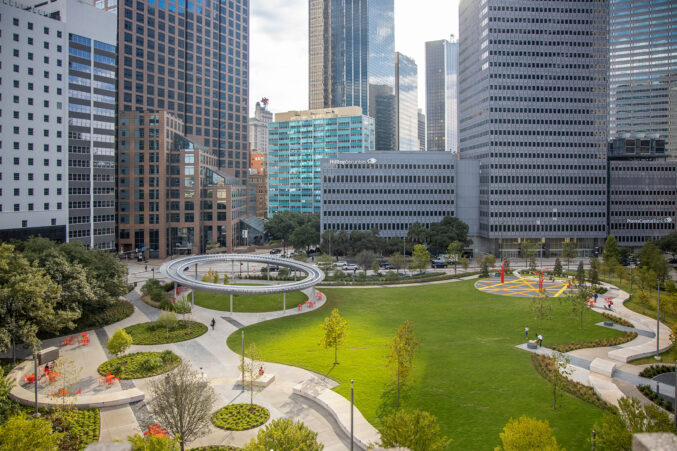I believe that quote is from Sir Mixmaster-a-lot.
Today brings news of Klyde Warren Deck Park’s caretakers asking for a Public Improvement District around its neighbors in the way of $250/year per every $1 million in appraised value. From their projected numbers, it looks like they’re looking for between $600K-$700K in additional operations revenue.
For reference, the proposed levy adds up to about $16,500/year on 1900 McKinney condo tower (if there are 100 condo owners that would equal another ~$60/month in homeowners dues) and $39,000/year for Trammell Crow Tower, owned by the Crescent/Ross Avenue Investors, which I assume is a legal entity under the broader Crescent umbrella. Those numbers aren’t outrageous, however when you start adding up all of the Crescent’s properties nearby and within the proposed PID boundary, I expect them to end up footing about a quarter of this bill.
I recall being at a public meeting where the designer of the park said the park was their and his idea, but as a prominent real estate developer accurately whispered, “that’s full of sh__.” That anecdote isn’t crucial to the story. I just like it.
Incidentally, the assessed value of Museum Tower is $194,000, which seems about right, so no worries there. (I’m kidding and I know the assessment is from before the opening. That I have to spell this out given past comments concerns me.)
———–
A couple other tangential questions, does the Federal Reserve pay? Do the tax exempt museums and performance halls?
———–
Dallas and downtown as well are tremendously over-amenitized, and particularly over-parked (parks and parking for that matter) in relation to the tax base available, which is why this additional localized revenue is necessary. Check the park acreage per capita in London sometime if you don’t believe me. The question is whether this undermines the intended Keynesian nature of the park. Spend on amenity to build density. Does the additional (albeit minor) cost upend that formula (which is admittedly backwards from the way cities historically evolved)?
“Too much amenity?!” That sounds bad. Everybody likes amenity. “Why you gotta be hatin’?!”
The need for the PID is as predictable as the indignation. “We have to pay for amenity?!” The purpose of the PID, however is to prevent additional levies upon the rest of the city. The thing about the PID is, “we” aren’t the ones paying. It’s the nearby property owners and they have to form a majority to do so. However, if that fails to achieve consensus. It is logical, those benefiting the most from increased property values via the park, should bear the greatest burden.
The public response is natural. In most cities, livable cities, we think of parks as amenities covered in our taxes, the price of admission into civilized society. This however is Dallas. It isn’t particularly livable nor civilized at present. This still holds true as the place we need to get to, but aren’t yet there.
The reality is that it takes density and tax base to afford such amenity. Absent that, it generally takes subsidy or charity to afford amenity. Of course, that generally only pays upfront costs. Afterwards, we have to figure out ways to maintain things. As district 14 council candidate Abtahi said in the Arts District forum the other night (paraphrased), “we have a tendency to build things and not maintain them.”
Such is the reality of anti-city. It’s the world we’ve created and now must somehow figure out a way to reverse engineer the logic and order of a real city.
Should the PID fail to materialize, let me propose another option: increasing the rate for parking in the area, meters, garages, and surface lots. I’d rather not (effectively) tax the property owners nearby as much as those driving into the area to use the park. This may or may not be true, but it seems many users are driving in to the city to experience the park.
“oh noez,” you say. “People won’t come into the city,” you say. It is the need for parking, surface and garage that places even greater cost on the nearby property owners than this proposed PID. Parking occupies valuable real estate, is extremely expensive to build (if it isn’t, ie underground), and if it isn’t underground the very presence devalues nearby property values. In effect, a double cost on the surrounding adjacencies.
If the park is to be sustainable and if it is that enjoyable, it will still draw people as will the various venues nearby. Train in or pay more for parking since otherwise, you’re the ones devaluing the place and the experience.
If people stop driving in and thereby start demanding more local amenities for themselves wherever they might reside, that is also a good thing. One, they shouldn’t have to drive 20 miles for amenity and they can pay for it with their own taxes. Two, less commuting users means less need for parking, which means more land available for densification and that increased tax base and downtown population to support all that amenity.





